HR Development: Individual, Team, and Organizational Strategies Report
VerifiedAdded on 2020/06/06
|15
|4335
|29
Report
AI Summary
This report, focused on developing individuals, teams, and organizations within an HR context, explores the essential skills and knowledge required by HR professionals. It delves into the importance of continuous professional development (CPD) and evaluates individual abilities through skill audits and development plans, using Jane Cambridge as a case study. The report differentiates between organizational and individual learning, highlighting their distinct characteristics and impacts. Furthermore, it examines the concept of High-Performance Working (HPW) and its role in fostering competitive advantage and employee engagement, along with various performance management strategies. The analysis includes self-assessment techniques, SWOT analysis, and CPDT methods to provide a comprehensive understanding of HR development and its practical applications. This report offers valuable insights for students studying leadership and management, providing a deep dive into the multifaceted aspects of HR development.
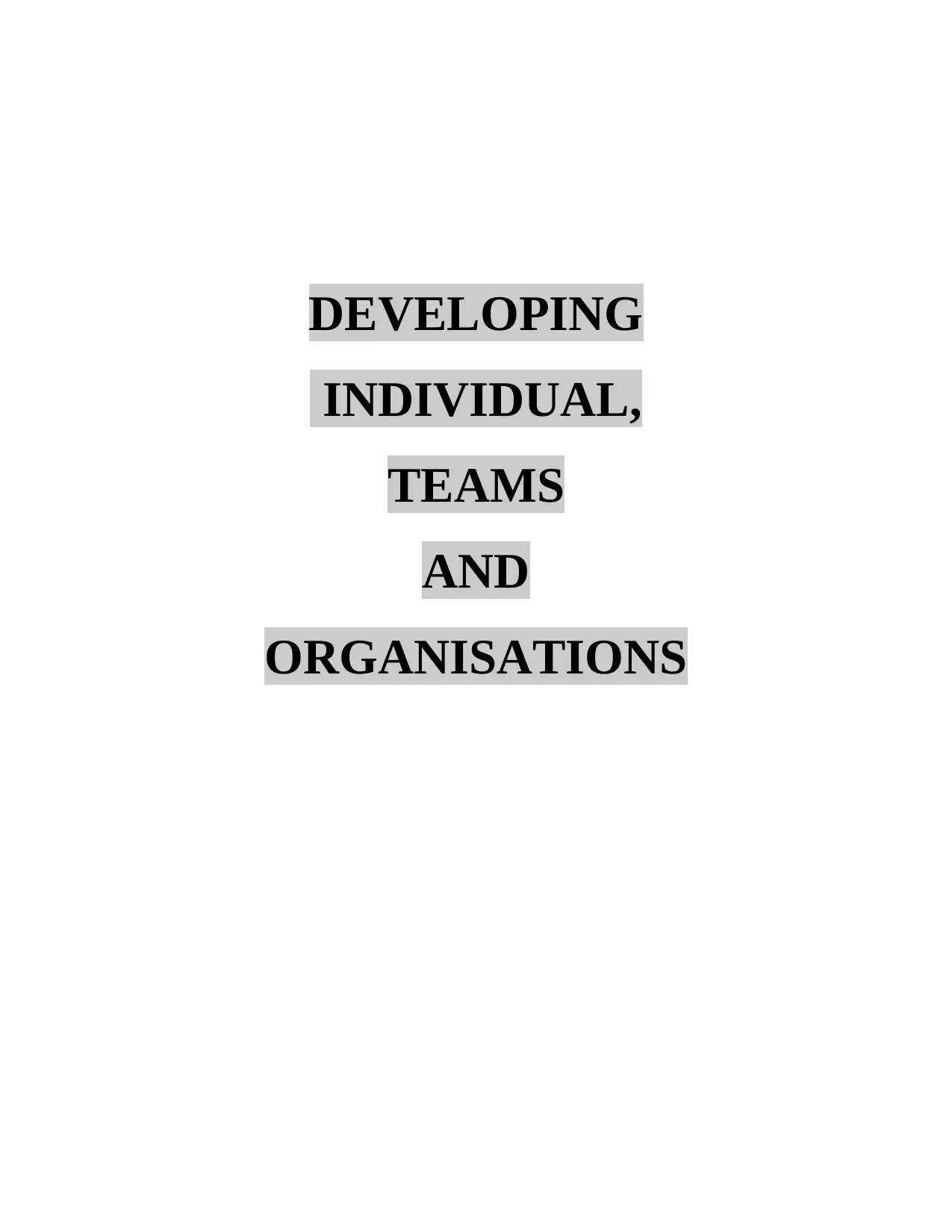
DEVELOPING
INDIVIDUAL,
TEAMS
AND
ORGANISATIONS
INDIVIDUAL,
TEAMS
AND
ORGANISATIONS
Paraphrase This Document
Need a fresh take? Get an instant paraphrase of this document with our AI Paraphraser
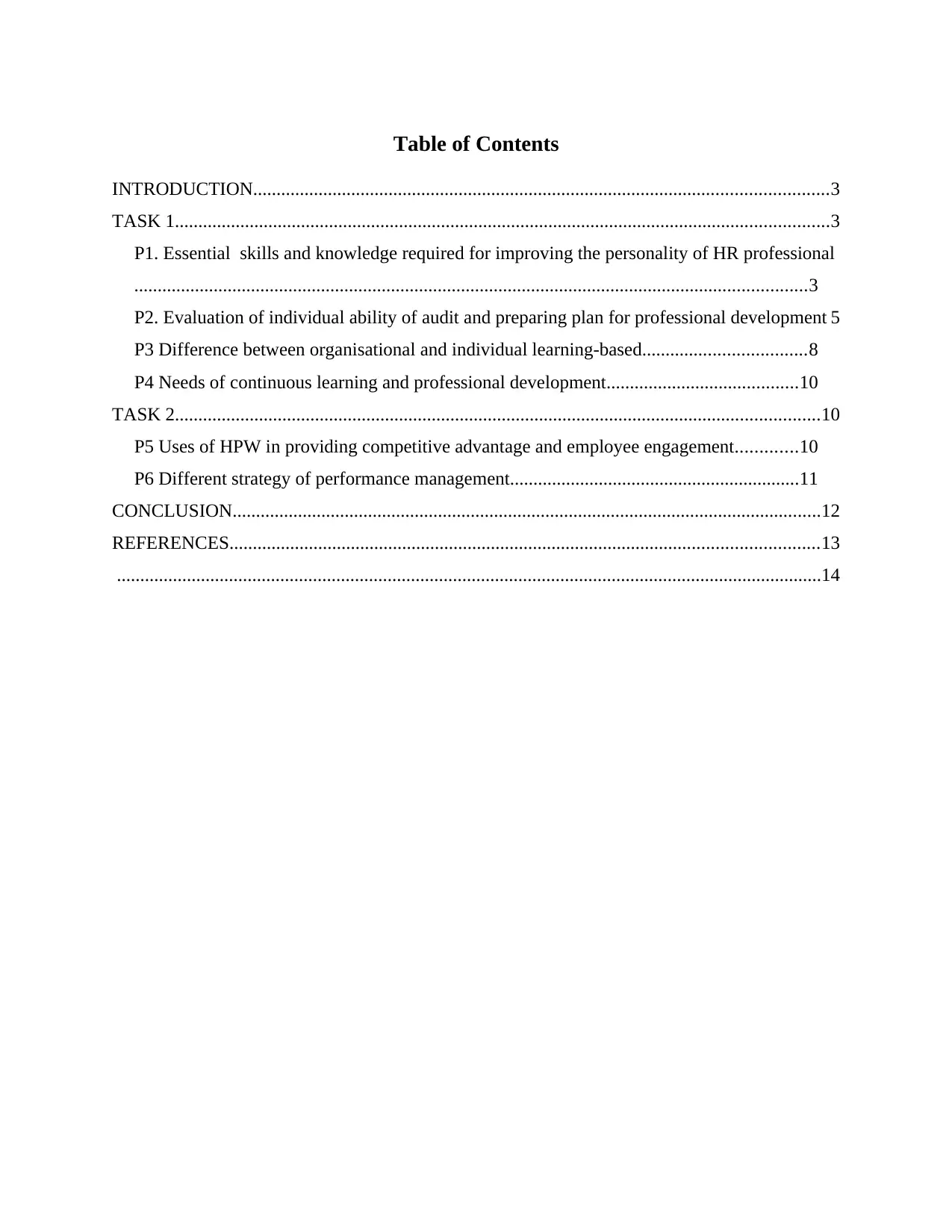
Table of Contents
INTRODUCTION...........................................................................................................................3
TASK 1............................................................................................................................................3
P1. Essential skills and knowledge required for improving the personality of HR professional
................................................................................................................................................3
P2. Evaluation of individual ability of audit and preparing plan for professional development 5
P3 Difference between organisational and individual learning-based...................................8
P4 Needs of continuous learning and professional development.........................................10
TASK 2..........................................................................................................................................10
P5 Uses of HPW in providing competitive advantage and employee engagement.............10
P6 Different strategy of performance management..............................................................11
CONCLUSION..............................................................................................................................12
REFERENCES..............................................................................................................................13
.......................................................................................................................................................14
INTRODUCTION...........................................................................................................................3
TASK 1............................................................................................................................................3
P1. Essential skills and knowledge required for improving the personality of HR professional
................................................................................................................................................3
P2. Evaluation of individual ability of audit and preparing plan for professional development 5
P3 Difference between organisational and individual learning-based...................................8
P4 Needs of continuous learning and professional development.........................................10
TASK 2..........................................................................................................................................10
P5 Uses of HPW in providing competitive advantage and employee engagement.............10
P6 Different strategy of performance management..............................................................11
CONCLUSION..............................................................................................................................12
REFERENCES..............................................................................................................................13
.......................................................................................................................................................14
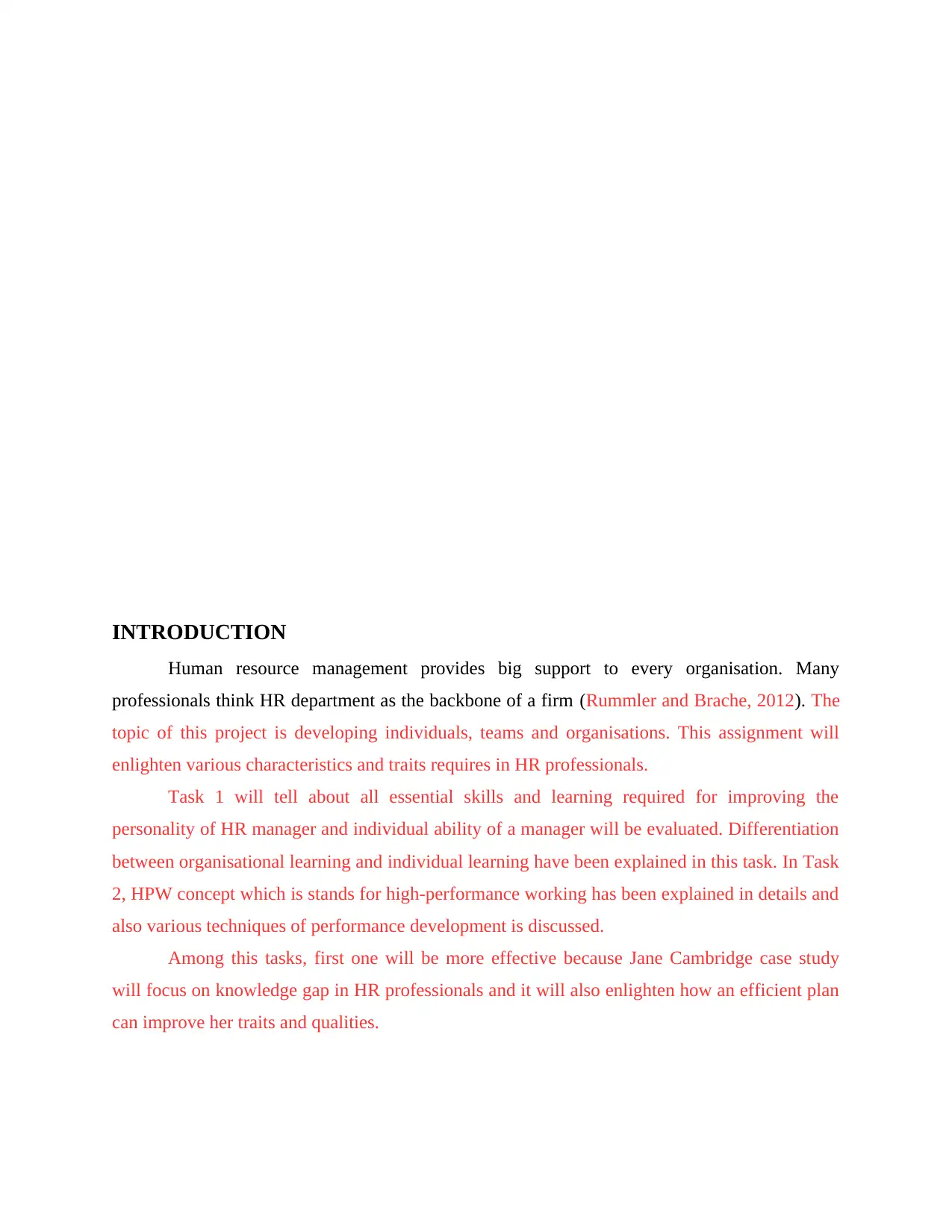
INTRODUCTION
Human resource management provides big support to every organisation. Many
professionals think HR department as the backbone of a firm (Rummler and Brache, 2012). The
topic of this project is developing individuals, teams and organisations. This assignment will
enlighten various characteristics and traits requires in HR professionals.
Task 1 will tell about all essential skills and learning required for improving the
personality of HR manager and individual ability of a manager will be evaluated. Differentiation
between organisational learning and individual learning have been explained in this task. In Task
2, HPW concept which is stands for high-performance working has been explained in details and
also various techniques of performance development is discussed.
Among this tasks, first one will be more effective because Jane Cambridge case study
will focus on knowledge gap in HR professionals and it will also enlighten how an efficient plan
can improve her traits and qualities.
Human resource management provides big support to every organisation. Many
professionals think HR department as the backbone of a firm (Rummler and Brache, 2012). The
topic of this project is developing individuals, teams and organisations. This assignment will
enlighten various characteristics and traits requires in HR professionals.
Task 1 will tell about all essential skills and learning required for improving the
personality of HR manager and individual ability of a manager will be evaluated. Differentiation
between organisational learning and individual learning have been explained in this task. In Task
2, HPW concept which is stands for high-performance working has been explained in details and
also various techniques of performance development is discussed.
Among this tasks, first one will be more effective because Jane Cambridge case study
will focus on knowledge gap in HR professionals and it will also enlighten how an efficient plan
can improve her traits and qualities.
⊘ This is a preview!⊘
Do you want full access?
Subscribe today to unlock all pages.

Trusted by 1+ million students worldwide
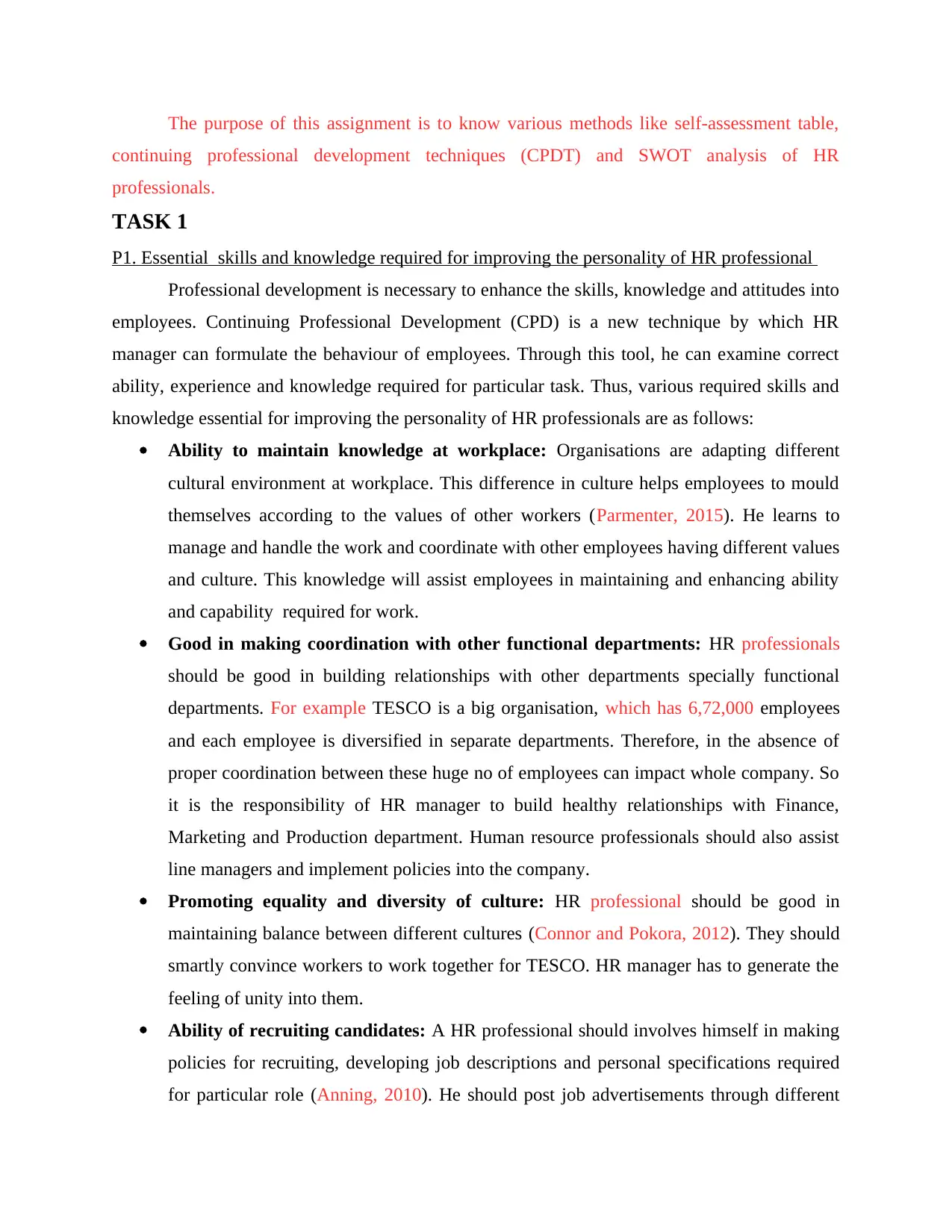
The purpose of this assignment is to know various methods like self-assessment table,
continuing professional development techniques (CPDT) and SWOT analysis of HR
professionals.
TASK 1
P1. Essential skills and knowledge required for improving the personality of HR professional
Professional development is necessary to enhance the skills, knowledge and attitudes into
employees. Continuing Professional Development (CPD) is a new technique by which HR
manager can formulate the behaviour of employees. Through this tool, he can examine correct
ability, experience and knowledge required for particular task. Thus, various required skills and
knowledge essential for improving the personality of HR professionals are as follows:
Ability to maintain knowledge at workplace: Organisations are adapting different
cultural environment at workplace. This difference in culture helps employees to mould
themselves according to the values of other workers (Parmenter, 2015). He learns to
manage and handle the work and coordinate with other employees having different values
and culture. This knowledge will assist employees in maintaining and enhancing ability
and capability required for work.
Good in making coordination with other functional departments: HR professionals
should be good in building relationships with other departments specially functional
departments. For example TESCO is a big organisation, which has 6,72,000 employees
and each employee is diversified in separate departments. Therefore, in the absence of
proper coordination between these huge no of employees can impact whole company. So
it is the responsibility of HR manager to build healthy relationships with Finance,
Marketing and Production department. Human resource professionals should also assist
line managers and implement policies into the company.
Promoting equality and diversity of culture: HR professional should be good in
maintaining balance between different cultures (Connor and Pokora, 2012). They should
smartly convince workers to work together for TESCO. HR manager has to generate the
feeling of unity into them.
Ability of recruiting candidates: A HR professional should involves himself in making
policies for recruiting, developing job descriptions and personal specifications required
for particular role (Anning, 2010). He should post job advertisements through different
continuing professional development techniques (CPDT) and SWOT analysis of HR
professionals.
TASK 1
P1. Essential skills and knowledge required for improving the personality of HR professional
Professional development is necessary to enhance the skills, knowledge and attitudes into
employees. Continuing Professional Development (CPD) is a new technique by which HR
manager can formulate the behaviour of employees. Through this tool, he can examine correct
ability, experience and knowledge required for particular task. Thus, various required skills and
knowledge essential for improving the personality of HR professionals are as follows:
Ability to maintain knowledge at workplace: Organisations are adapting different
cultural environment at workplace. This difference in culture helps employees to mould
themselves according to the values of other workers (Parmenter, 2015). He learns to
manage and handle the work and coordinate with other employees having different values
and culture. This knowledge will assist employees in maintaining and enhancing ability
and capability required for work.
Good in making coordination with other functional departments: HR professionals
should be good in building relationships with other departments specially functional
departments. For example TESCO is a big organisation, which has 6,72,000 employees
and each employee is diversified in separate departments. Therefore, in the absence of
proper coordination between these huge no of employees can impact whole company. So
it is the responsibility of HR manager to build healthy relationships with Finance,
Marketing and Production department. Human resource professionals should also assist
line managers and implement policies into the company.
Promoting equality and diversity of culture: HR professional should be good in
maintaining balance between different cultures (Connor and Pokora, 2012). They should
smartly convince workers to work together for TESCO. HR manager has to generate the
feeling of unity into them.
Ability of recruiting candidates: A HR professional should involves himself in making
policies for recruiting, developing job descriptions and personal specifications required
for particular role (Anning, 2010). He should post job advertisements through different
Paraphrase This Document
Need a fresh take? Get an instant paraphrase of this document with our AI Paraphraser
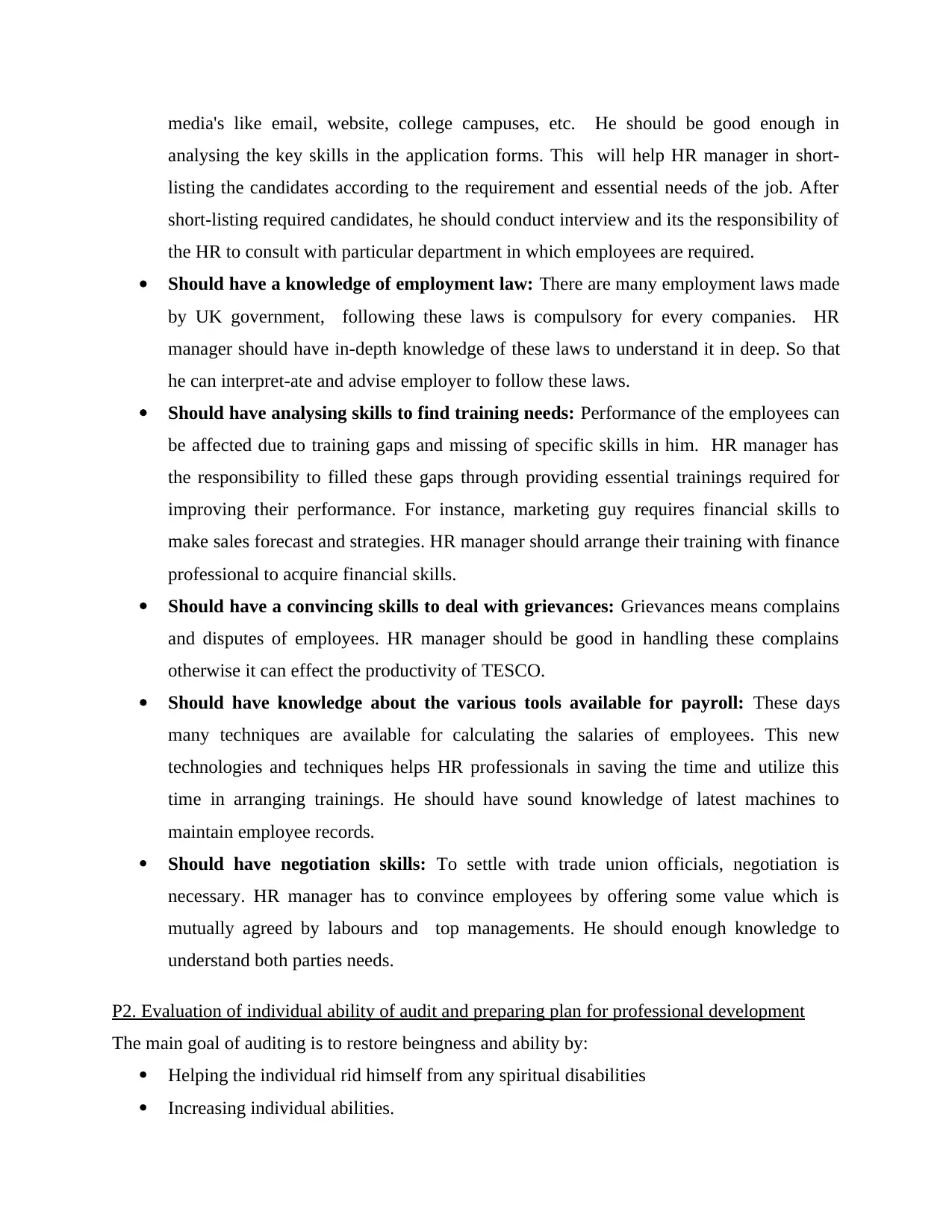
media's like email, website, college campuses, etc. He should be good enough in
analysing the key skills in the application forms. This will help HR manager in short-
listing the candidates according to the requirement and essential needs of the job. After
short-listing required candidates, he should conduct interview and its the responsibility of
the HR to consult with particular department in which employees are required.
Should have a knowledge of employment law: There are many employment laws made
by UK government, following these laws is compulsory for every companies. HR
manager should have in-depth knowledge of these laws to understand it in deep. So that
he can interpret-ate and advise employer to follow these laws.
Should have analysing skills to find training needs: Performance of the employees can
be affected due to training gaps and missing of specific skills in him. HR manager has
the responsibility to filled these gaps through providing essential trainings required for
improving their performance. For instance, marketing guy requires financial skills to
make sales forecast and strategies. HR manager should arrange their training with finance
professional to acquire financial skills.
Should have a convincing skills to deal with grievances: Grievances means complains
and disputes of employees. HR manager should be good in handling these complains
otherwise it can effect the productivity of TESCO.
Should have knowledge about the various tools available for payroll: These days
many techniques are available for calculating the salaries of employees. This new
technologies and techniques helps HR professionals in saving the time and utilize this
time in arranging trainings. He should have sound knowledge of latest machines to
maintain employee records.
Should have negotiation skills: To settle with trade union officials, negotiation is
necessary. HR manager has to convince employees by offering some value which is
mutually agreed by labours and top managements. He should enough knowledge to
understand both parties needs.
P2. Evaluation of individual ability of audit and preparing plan for professional development
The main goal of auditing is to restore beingness and ability by:
Helping the individual rid himself from any spiritual disabilities
Increasing individual abilities.
analysing the key skills in the application forms. This will help HR manager in short-
listing the candidates according to the requirement and essential needs of the job. After
short-listing required candidates, he should conduct interview and its the responsibility of
the HR to consult with particular department in which employees are required.
Should have a knowledge of employment law: There are many employment laws made
by UK government, following these laws is compulsory for every companies. HR
manager should have in-depth knowledge of these laws to understand it in deep. So that
he can interpret-ate and advise employer to follow these laws.
Should have analysing skills to find training needs: Performance of the employees can
be affected due to training gaps and missing of specific skills in him. HR manager has
the responsibility to filled these gaps through providing essential trainings required for
improving their performance. For instance, marketing guy requires financial skills to
make sales forecast and strategies. HR manager should arrange their training with finance
professional to acquire financial skills.
Should have a convincing skills to deal with grievances: Grievances means complains
and disputes of employees. HR manager should be good in handling these complains
otherwise it can effect the productivity of TESCO.
Should have knowledge about the various tools available for payroll: These days
many techniques are available for calculating the salaries of employees. This new
technologies and techniques helps HR professionals in saving the time and utilize this
time in arranging trainings. He should have sound knowledge of latest machines to
maintain employee records.
Should have negotiation skills: To settle with trade union officials, negotiation is
necessary. HR manager has to convince employees by offering some value which is
mutually agreed by labours and top managements. He should enough knowledge to
understand both parties needs.
P2. Evaluation of individual ability of audit and preparing plan for professional development
The main goal of auditing is to restore beingness and ability by:
Helping the individual rid himself from any spiritual disabilities
Increasing individual abilities.
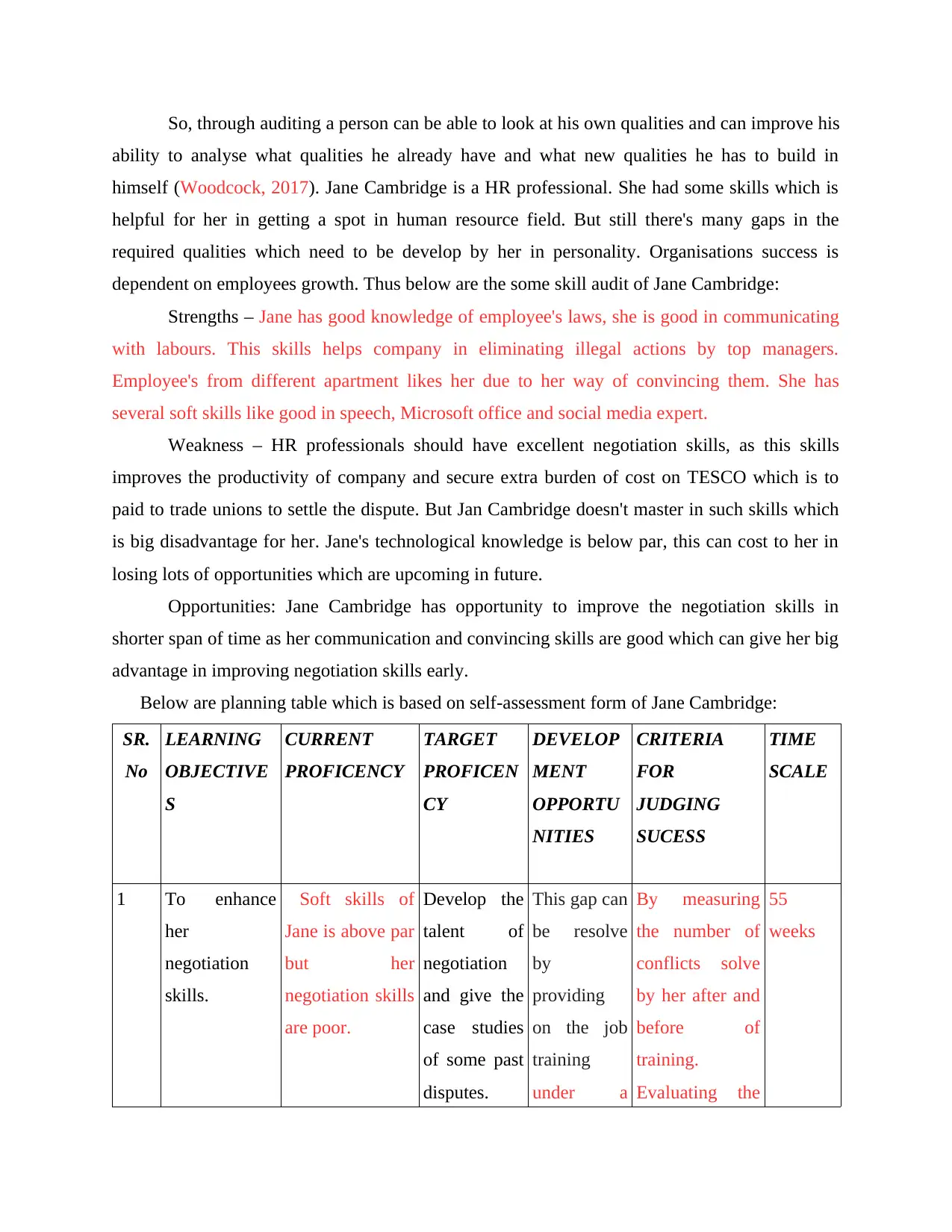
So, through auditing a person can be able to look at his own qualities and can improve his
ability to analyse what qualities he already have and what new qualities he has to build in
himself (Woodcock, 2017). Jane Cambridge is a HR professional. She had some skills which is
helpful for her in getting a spot in human resource field. But still there's many gaps in the
required qualities which need to be develop by her in personality. Organisations success is
dependent on employees growth. Thus below are the some skill audit of Jane Cambridge:
Strengths – Jane has good knowledge of employee's laws, she is good in communicating
with labours. This skills helps company in eliminating illegal actions by top managers.
Employee's from different apartment likes her due to her way of convincing them. She has
several soft skills like good in speech, Microsoft office and social media expert.
Weakness – HR professionals should have excellent negotiation skills, as this skills
improves the productivity of company and secure extra burden of cost on TESCO which is to
paid to trade unions to settle the dispute. But Jan Cambridge doesn't master in such skills which
is big disadvantage for her. Jane's technological knowledge is below par, this can cost to her in
losing lots of opportunities which are upcoming in future.
Opportunities: Jane Cambridge has opportunity to improve the negotiation skills in
shorter span of time as her communication and convincing skills are good which can give her big
advantage in improving negotiation skills early.
Below are planning table which is based on self-assessment form of Jane Cambridge:
SR.
No
LEARNING
OBJECTIVE
S
CURRENT
PROFICENCY
TARGET
PROFICEN
CY
DEVELOP
MENT
OPPORTU
NITIES
CRITERIA
FOR
JUDGING
SUCESS
TIME
SCALE
1 To enhance
her
negotiation
skills.
Soft skills of
Jane is above par
but her
negotiation skills
are poor.
Develop the
talent of
negotiation
and give the
case studies
of some past
disputes.
This gap can
be resolve
by
providing
on the job
training
under a
By measuring
the number of
conflicts solve
by her after and
before of
training.
Evaluating the
55
weeks
ability to analyse what qualities he already have and what new qualities he has to build in
himself (Woodcock, 2017). Jane Cambridge is a HR professional. She had some skills which is
helpful for her in getting a spot in human resource field. But still there's many gaps in the
required qualities which need to be develop by her in personality. Organisations success is
dependent on employees growth. Thus below are the some skill audit of Jane Cambridge:
Strengths – Jane has good knowledge of employee's laws, she is good in communicating
with labours. This skills helps company in eliminating illegal actions by top managers.
Employee's from different apartment likes her due to her way of convincing them. She has
several soft skills like good in speech, Microsoft office and social media expert.
Weakness – HR professionals should have excellent negotiation skills, as this skills
improves the productivity of company and secure extra burden of cost on TESCO which is to
paid to trade unions to settle the dispute. But Jan Cambridge doesn't master in such skills which
is big disadvantage for her. Jane's technological knowledge is below par, this can cost to her in
losing lots of opportunities which are upcoming in future.
Opportunities: Jane Cambridge has opportunity to improve the negotiation skills in
shorter span of time as her communication and convincing skills are good which can give her big
advantage in improving negotiation skills early.
Below are planning table which is based on self-assessment form of Jane Cambridge:
SR.
No
LEARNING
OBJECTIVE
S
CURRENT
PROFICENCY
TARGET
PROFICEN
CY
DEVELOP
MENT
OPPORTU
NITIES
CRITERIA
FOR
JUDGING
SUCESS
TIME
SCALE
1 To enhance
her
negotiation
skills.
Soft skills of
Jane is above par
but her
negotiation skills
are poor.
Develop the
talent of
negotiation
and give the
case studies
of some past
disputes.
This gap can
be resolve
by
providing
on the job
training
under a
By measuring
the number of
conflicts solve
by her after and
before of
training.
Evaluating the
55
weeks
⊘ This is a preview!⊘
Do you want full access?
Subscribe today to unlock all pages.

Trusted by 1+ million students worldwide
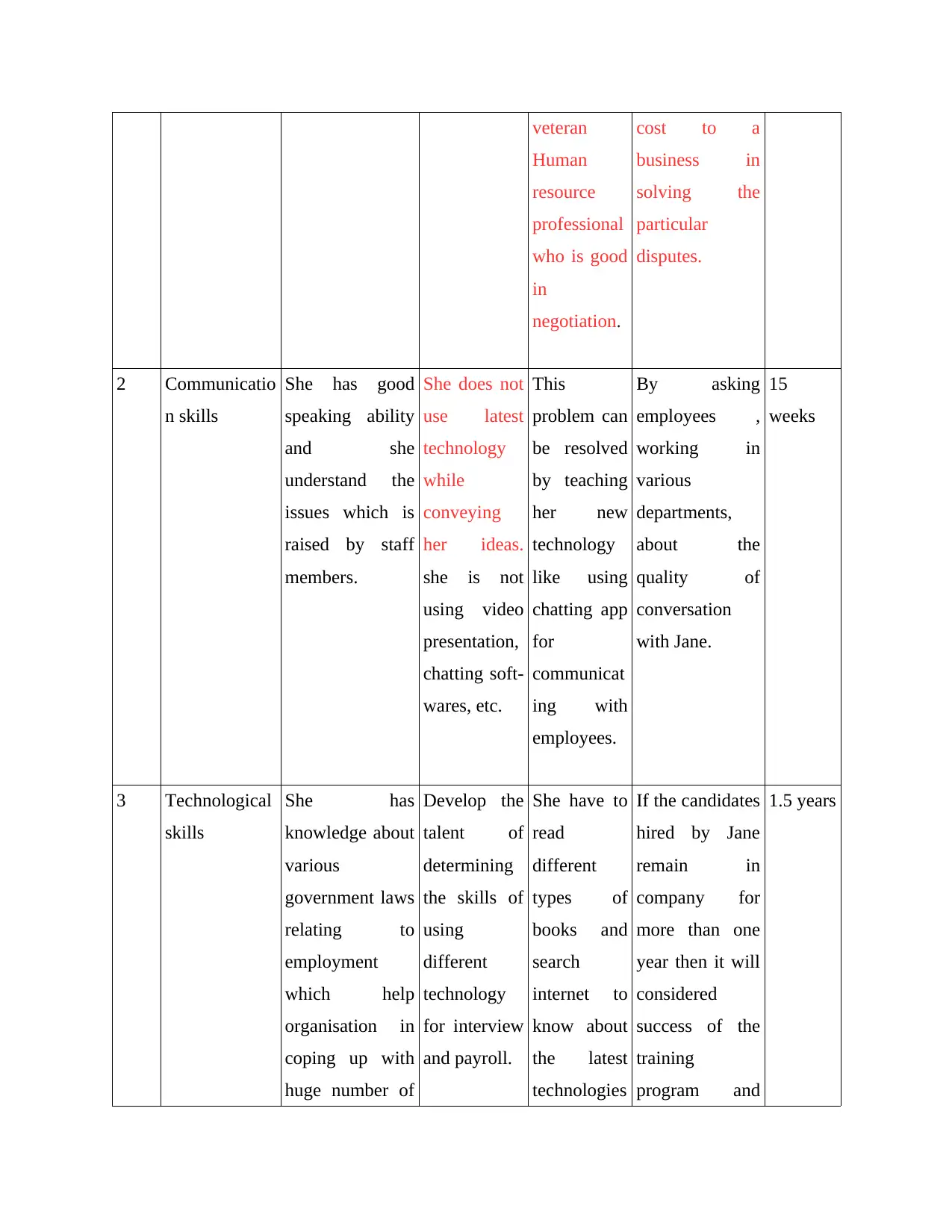
veteran
Human
resource
professional
who is good
in
negotiation.
cost to a
business in
solving the
particular
disputes.
2 Communicatio
n skills
She has good
speaking ability
and she
understand the
issues which is
raised by staff
members.
She does not
use latest
technology
while
conveying
her ideas.
she is not
using video
presentation,
chatting soft-
wares, etc.
This
problem can
be resolved
by teaching
her new
technology
like using
chatting app
for
communicat
ing with
employees.
By asking
employees ,
working in
various
departments,
about the
quality of
conversation
with Jane.
15
weeks
3 Technological
skills
She has
knowledge about
various
government laws
relating to
employment
which help
organisation in
coping up with
huge number of
Develop the
talent of
determining
the skills of
using
different
technology
for interview
and payroll.
She have to
read
different
types of
books and
search
internet to
know about
the latest
technologies
If the candidates
hired by Jane
remain in
company for
more than one
year then it will
considered
success of the
training
program and
1.5 years
Human
resource
professional
who is good
in
negotiation.
cost to a
business in
solving the
particular
disputes.
2 Communicatio
n skills
She has good
speaking ability
and she
understand the
issues which is
raised by staff
members.
She does not
use latest
technology
while
conveying
her ideas.
she is not
using video
presentation,
chatting soft-
wares, etc.
This
problem can
be resolved
by teaching
her new
technology
like using
chatting app
for
communicat
ing with
employees.
By asking
employees ,
working in
various
departments,
about the
quality of
conversation
with Jane.
15
weeks
3 Technological
skills
She has
knowledge about
various
government laws
relating to
employment
which help
organisation in
coping up with
huge number of
Develop the
talent of
determining
the skills of
using
different
technology
for interview
and payroll.
She have to
read
different
types of
books and
search
internet to
know about
the latest
technologies
If the candidates
hired by Jane
remain in
company for
more than one
year then it will
considered
success of the
training
program and
1.5 years
Paraphrase This Document
Need a fresh take? Get an instant paraphrase of this document with our AI Paraphraser
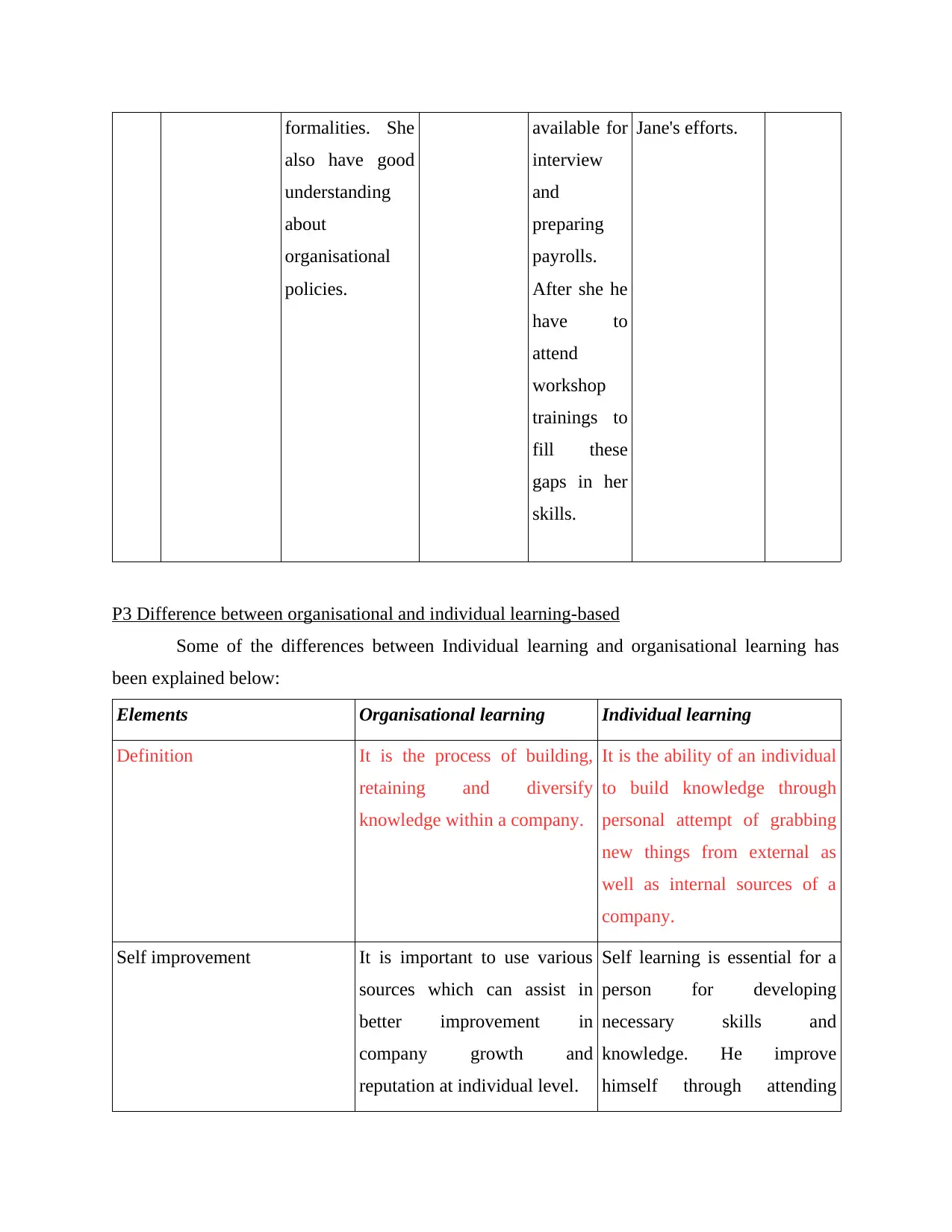
formalities. She
also have good
understanding
about
organisational
policies.
available for
interview
and
preparing
payrolls.
After she he
have to
attend
workshop
trainings to
fill these
gaps in her
skills.
Jane's efforts.
P3 Difference between organisational and individual learning-based
Some of the differences between Individual learning and organisational learning has
been explained below:
Elements Organisational learning Individual learning
Definition It is the process of building,
retaining and diversify
knowledge within a company.
It is the ability of an individual
to build knowledge through
personal attempt of grabbing
new things from external as
well as internal sources of a
company.
Self improvement It is important to use various
sources which can assist in
better improvement in
company growth and
reputation at individual level.
Self learning is essential for a
person for developing
necessary skills and
knowledge. He improve
himself through attending
also have good
understanding
about
organisational
policies.
available for
interview
and
preparing
payrolls.
After she he
have to
attend
workshop
trainings to
fill these
gaps in her
skills.
Jane's efforts.
P3 Difference between organisational and individual learning-based
Some of the differences between Individual learning and organisational learning has
been explained below:
Elements Organisational learning Individual learning
Definition It is the process of building,
retaining and diversify
knowledge within a company.
It is the ability of an individual
to build knowledge through
personal attempt of grabbing
new things from external as
well as internal sources of a
company.
Self improvement It is important to use various
sources which can assist in
better improvement in
company growth and
reputation at individual level.
Self learning is essential for a
person for developing
necessary skills and
knowledge. He improve
himself through attending
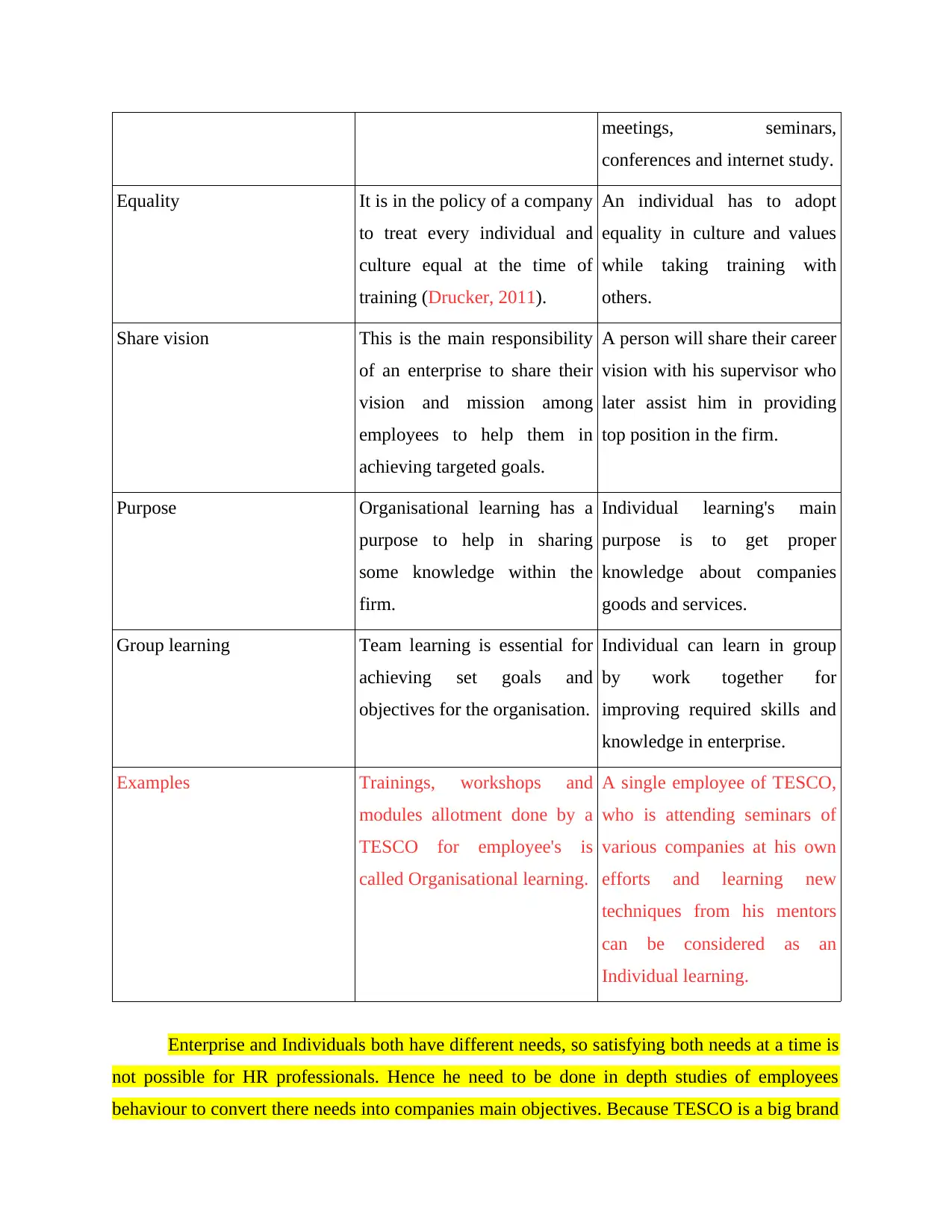
meetings, seminars,
conferences and internet study.
Equality It is in the policy of a company
to treat every individual and
culture equal at the time of
training (Drucker, 2011).
An individual has to adopt
equality in culture and values
while taking training with
others.
Share vision This is the main responsibility
of an enterprise to share their
vision and mission among
employees to help them in
achieving targeted goals.
A person will share their career
vision with his supervisor who
later assist him in providing
top position in the firm.
Purpose Organisational learning has a
purpose to help in sharing
some knowledge within the
firm.
Individual learning's main
purpose is to get proper
knowledge about companies
goods and services.
Group learning Team learning is essential for
achieving set goals and
objectives for the organisation.
Individual can learn in group
by work together for
improving required skills and
knowledge in enterprise.
Examples Trainings, workshops and
modules allotment done by a
TESCO for employee's is
called Organisational learning.
A single employee of TESCO,
who is attending seminars of
various companies at his own
efforts and learning new
techniques from his mentors
can be considered as an
Individual learning.
Enterprise and Individuals both have different needs, so satisfying both needs at a time is
not possible for HR professionals. Hence he need to be done in depth studies of employees
behaviour to convert there needs into companies main objectives. Because TESCO is a big brand
conferences and internet study.
Equality It is in the policy of a company
to treat every individual and
culture equal at the time of
training (Drucker, 2011).
An individual has to adopt
equality in culture and values
while taking training with
others.
Share vision This is the main responsibility
of an enterprise to share their
vision and mission among
employees to help them in
achieving targeted goals.
A person will share their career
vision with his supervisor who
later assist him in providing
top position in the firm.
Purpose Organisational learning has a
purpose to help in sharing
some knowledge within the
firm.
Individual learning's main
purpose is to get proper
knowledge about companies
goods and services.
Group learning Team learning is essential for
achieving set goals and
objectives for the organisation.
Individual can learn in group
by work together for
improving required skills and
knowledge in enterprise.
Examples Trainings, workshops and
modules allotment done by a
TESCO for employee's is
called Organisational learning.
A single employee of TESCO,
who is attending seminars of
various companies at his own
efforts and learning new
techniques from his mentors
can be considered as an
Individual learning.
Enterprise and Individuals both have different needs, so satisfying both needs at a time is
not possible for HR professionals. Hence he need to be done in depth studies of employees
behaviour to convert there needs into companies main objectives. Because TESCO is a big brand
⊘ This is a preview!⊘
Do you want full access?
Subscribe today to unlock all pages.

Trusted by 1+ million students worldwide
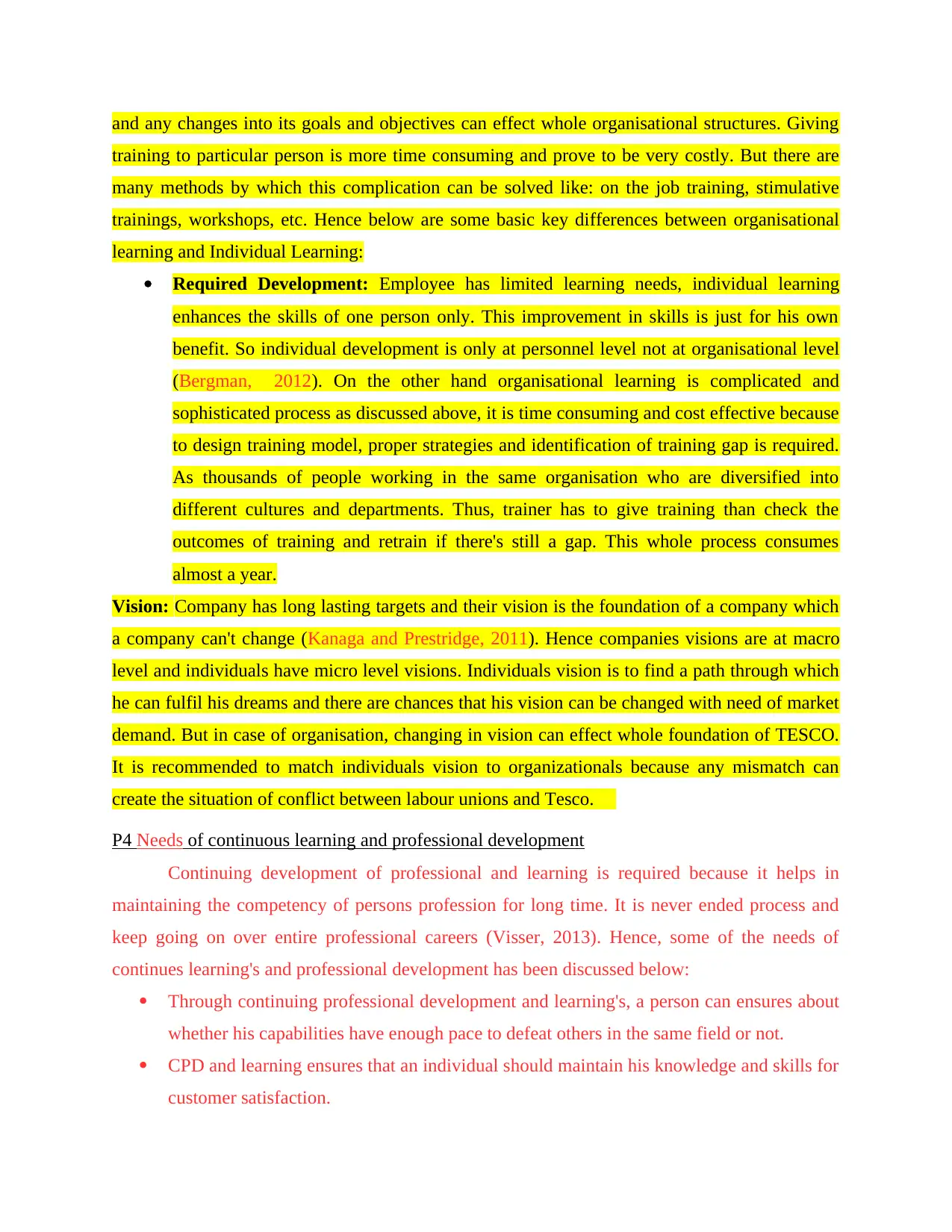
and any changes into its goals and objectives can effect whole organisational structures. Giving
training to particular person is more time consuming and prove to be very costly. But there are
many methods by which this complication can be solved like: on the job training, stimulative
trainings, workshops, etc. Hence below are some basic key differences between organisational
learning and Individual Learning:
Required Development: Employee has limited learning needs, individual learning
enhances the skills of one person only. This improvement in skills is just for his own
benefit. So individual development is only at personnel level not at organisational level
(Bergman, 2012). On the other hand organisational learning is complicated and
sophisticated process as discussed above, it is time consuming and cost effective because
to design training model, proper strategies and identification of training gap is required.
As thousands of people working in the same organisation who are diversified into
different cultures and departments. Thus, trainer has to give training than check the
outcomes of training and retrain if there's still a gap. This whole process consumes
almost a year.
Vision: Company has long lasting targets and their vision is the foundation of a company which
a company can't change (Kanaga and Prestridge, 2011). Hence companies visions are at macro
level and individuals have micro level visions. Individuals vision is to find a path through which
he can fulfil his dreams and there are chances that his vision can be changed with need of market
demand. But in case of organisation, changing in vision can effect whole foundation of TESCO.
It is recommended to match individuals vision to organizationals because any mismatch can
create the situation of conflict between labour unions and Tesco.
P4 Needs of continuous learning and professional development
Continuing development of professional and learning is required because it helps in
maintaining the competency of persons profession for long time. It is never ended process and
keep going on over entire professional careers (Visser, 2013). Hence, some of the needs of
continues learning's and professional development has been discussed below:
Through continuing professional development and learning's, a person can ensures about
whether his capabilities have enough pace to defeat others in the same field or not.
CPD and learning ensures that an individual should maintain his knowledge and skills for
customer satisfaction.
training to particular person is more time consuming and prove to be very costly. But there are
many methods by which this complication can be solved like: on the job training, stimulative
trainings, workshops, etc. Hence below are some basic key differences between organisational
learning and Individual Learning:
Required Development: Employee has limited learning needs, individual learning
enhances the skills of one person only. This improvement in skills is just for his own
benefit. So individual development is only at personnel level not at organisational level
(Bergman, 2012). On the other hand organisational learning is complicated and
sophisticated process as discussed above, it is time consuming and cost effective because
to design training model, proper strategies and identification of training gap is required.
As thousands of people working in the same organisation who are diversified into
different cultures and departments. Thus, trainer has to give training than check the
outcomes of training and retrain if there's still a gap. This whole process consumes
almost a year.
Vision: Company has long lasting targets and their vision is the foundation of a company which
a company can't change (Kanaga and Prestridge, 2011). Hence companies visions are at macro
level and individuals have micro level visions. Individuals vision is to find a path through which
he can fulfil his dreams and there are chances that his vision can be changed with need of market
demand. But in case of organisation, changing in vision can effect whole foundation of TESCO.
It is recommended to match individuals vision to organizationals because any mismatch can
create the situation of conflict between labour unions and Tesco.
P4 Needs of continuous learning and professional development
Continuing development of professional and learning is required because it helps in
maintaining the competency of persons profession for long time. It is never ended process and
keep going on over entire professional careers (Visser, 2013). Hence, some of the needs of
continues learning's and professional development has been discussed below:
Through continuing professional development and learning's, a person can ensures about
whether his capabilities have enough pace to defeat others in the same field or not.
CPD and learning ensures that an individual should maintain his knowledge and skills for
customer satisfaction.
Paraphrase This Document
Need a fresh take? Get an instant paraphrase of this document with our AI Paraphraser
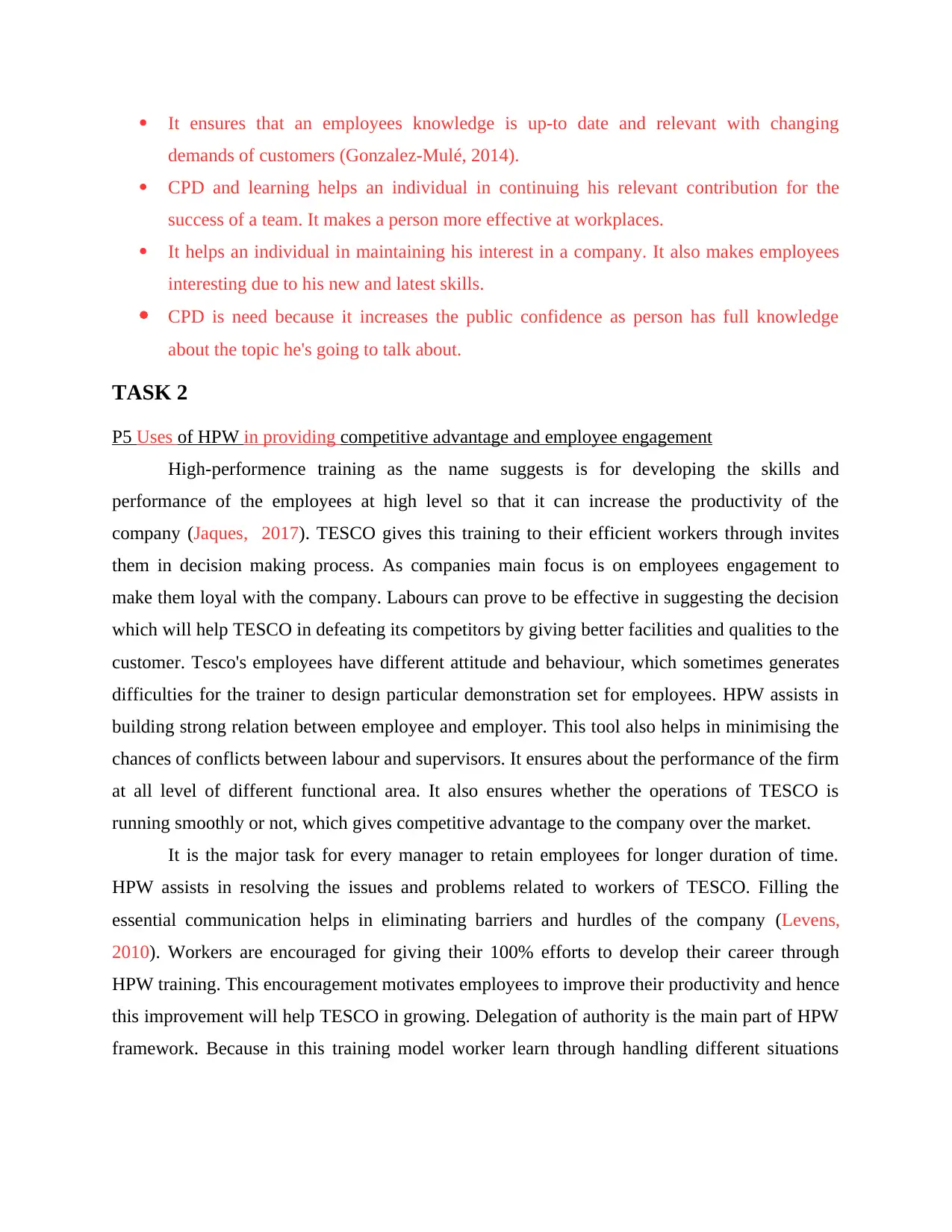
It ensures that an employees knowledge is up-to date and relevant with changing
demands of customers (Gonzalez-Mulé, 2014).
CPD and learning helps an individual in continuing his relevant contribution for the
success of a team. It makes a person more effective at workplaces.
It helps an individual in maintaining his interest in a company. It also makes employees
interesting due to his new and latest skills.
CPD is need because it increases the public confidence as person has full knowledge
about the topic he's going to talk about.
TASK 2
P5 Uses of HPW in providing competitive advantage and employee engagement
High-performence training as the name suggests is for developing the skills and
performance of the employees at high level so that it can increase the productivity of the
company (Jaques, 2017). TESCO gives this training to their efficient workers through invites
them in decision making process. As companies main focus is on employees engagement to
make them loyal with the company. Labours can prove to be effective in suggesting the decision
which will help TESCO in defeating its competitors by giving better facilities and qualities to the
customer. Tesco's employees have different attitude and behaviour, which sometimes generates
difficulties for the trainer to design particular demonstration set for employees. HPW assists in
building strong relation between employee and employer. This tool also helps in minimising the
chances of conflicts between labour and supervisors. It ensures about the performance of the firm
at all level of different functional area. It also ensures whether the operations of TESCO is
running smoothly or not, which gives competitive advantage to the company over the market.
It is the major task for every manager to retain employees for longer duration of time.
HPW assists in resolving the issues and problems related to workers of TESCO. Filling the
essential communication helps in eliminating barriers and hurdles of the company (Levens,
2010). Workers are encouraged for giving their 100% efforts to develop their career through
HPW training. This encouragement motivates employees to improve their productivity and hence
this improvement will help TESCO in growing. Delegation of authority is the main part of HPW
framework. Because in this training model worker learn through handling different situations
demands of customers (Gonzalez-Mulé, 2014).
CPD and learning helps an individual in continuing his relevant contribution for the
success of a team. It makes a person more effective at workplaces.
It helps an individual in maintaining his interest in a company. It also makes employees
interesting due to his new and latest skills.
CPD is need because it increases the public confidence as person has full knowledge
about the topic he's going to talk about.
TASK 2
P5 Uses of HPW in providing competitive advantage and employee engagement
High-performence training as the name suggests is for developing the skills and
performance of the employees at high level so that it can increase the productivity of the
company (Jaques, 2017). TESCO gives this training to their efficient workers through invites
them in decision making process. As companies main focus is on employees engagement to
make them loyal with the company. Labours can prove to be effective in suggesting the decision
which will help TESCO in defeating its competitors by giving better facilities and qualities to the
customer. Tesco's employees have different attitude and behaviour, which sometimes generates
difficulties for the trainer to design particular demonstration set for employees. HPW assists in
building strong relation between employee and employer. This tool also helps in minimising the
chances of conflicts between labour and supervisors. It ensures about the performance of the firm
at all level of different functional area. It also ensures whether the operations of TESCO is
running smoothly or not, which gives competitive advantage to the company over the market.
It is the major task for every manager to retain employees for longer duration of time.
HPW assists in resolving the issues and problems related to workers of TESCO. Filling the
essential communication helps in eliminating barriers and hurdles of the company (Levens,
2010). Workers are encouraged for giving their 100% efforts to develop their career through
HPW training. This encouragement motivates employees to improve their productivity and hence
this improvement will help TESCO in growing. Delegation of authority is the main part of HPW
framework. Because in this training model worker learn through handling different situations
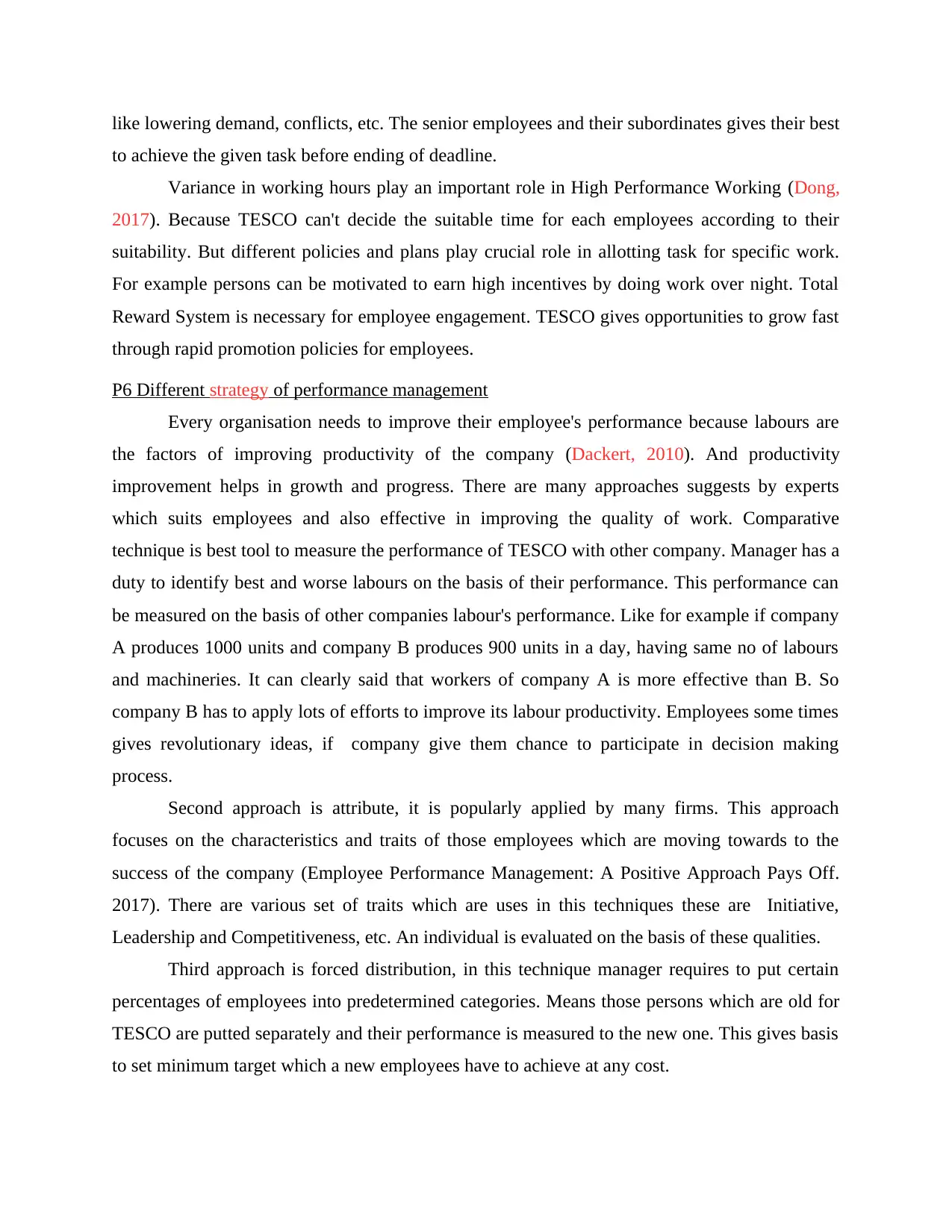
like lowering demand, conflicts, etc. The senior employees and their subordinates gives their best
to achieve the given task before ending of deadline.
Variance in working hours play an important role in High Performance Working (Dong,
2017). Because TESCO can't decide the suitable time for each employees according to their
suitability. But different policies and plans play crucial role in allotting task for specific work.
For example persons can be motivated to earn high incentives by doing work over night. Total
Reward System is necessary for employee engagement. TESCO gives opportunities to grow fast
through rapid promotion policies for employees.
P6 Different strategy of performance management
Every organisation needs to improve their employee's performance because labours are
the factors of improving productivity of the company (Dackert, 2010). And productivity
improvement helps in growth and progress. There are many approaches suggests by experts
which suits employees and also effective in improving the quality of work. Comparative
technique is best tool to measure the performance of TESCO with other company. Manager has a
duty to identify best and worse labours on the basis of their performance. This performance can
be measured on the basis of other companies labour's performance. Like for example if company
A produces 1000 units and company B produces 900 units in a day, having same no of labours
and machineries. It can clearly said that workers of company A is more effective than B. So
company B has to apply lots of efforts to improve its labour productivity. Employees some times
gives revolutionary ideas, if company give them chance to participate in decision making
process.
Second approach is attribute, it is popularly applied by many firms. This approach
focuses on the characteristics and traits of those employees which are moving towards to the
success of the company (Employee Performance Management: A Positive Approach Pays Off.
2017). There are various set of traits which are uses in this techniques these are Initiative,
Leadership and Competitiveness, etc. An individual is evaluated on the basis of these qualities.
Third approach is forced distribution, in this technique manager requires to put certain
percentages of employees into predetermined categories. Means those persons which are old for
TESCO are putted separately and their performance is measured to the new one. This gives basis
to set minimum target which a new employees have to achieve at any cost.
to achieve the given task before ending of deadline.
Variance in working hours play an important role in High Performance Working (Dong,
2017). Because TESCO can't decide the suitable time for each employees according to their
suitability. But different policies and plans play crucial role in allotting task for specific work.
For example persons can be motivated to earn high incentives by doing work over night. Total
Reward System is necessary for employee engagement. TESCO gives opportunities to grow fast
through rapid promotion policies for employees.
P6 Different strategy of performance management
Every organisation needs to improve their employee's performance because labours are
the factors of improving productivity of the company (Dackert, 2010). And productivity
improvement helps in growth and progress. There are many approaches suggests by experts
which suits employees and also effective in improving the quality of work. Comparative
technique is best tool to measure the performance of TESCO with other company. Manager has a
duty to identify best and worse labours on the basis of their performance. This performance can
be measured on the basis of other companies labour's performance. Like for example if company
A produces 1000 units and company B produces 900 units in a day, having same no of labours
and machineries. It can clearly said that workers of company A is more effective than B. So
company B has to apply lots of efforts to improve its labour productivity. Employees some times
gives revolutionary ideas, if company give them chance to participate in decision making
process.
Second approach is attribute, it is popularly applied by many firms. This approach
focuses on the characteristics and traits of those employees which are moving towards to the
success of the company (Employee Performance Management: A Positive Approach Pays Off.
2017). There are various set of traits which are uses in this techniques these are Initiative,
Leadership and Competitiveness, etc. An individual is evaluated on the basis of these qualities.
Third approach is forced distribution, in this technique manager requires to put certain
percentages of employees into predetermined categories. Means those persons which are old for
TESCO are putted separately and their performance is measured to the new one. This gives basis
to set minimum target which a new employees have to achieve at any cost.
⊘ This is a preview!⊘
Do you want full access?
Subscribe today to unlock all pages.

Trusted by 1+ million students worldwide
1 out of 15
Related Documents
Your All-in-One AI-Powered Toolkit for Academic Success.
+13062052269
info@desklib.com
Available 24*7 on WhatsApp / Email
![[object Object]](/_next/static/media/star-bottom.7253800d.svg)
Unlock your academic potential
Copyright © 2020–2025 A2Z Services. All Rights Reserved. Developed and managed by ZUCOL.




